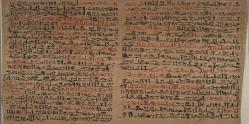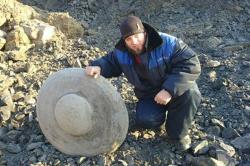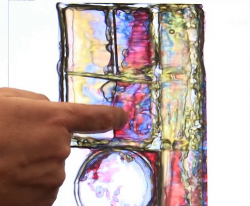INSTITUT SUPERIEUR D'ANTHROPOLOGIE
INSTITUTE OF ANTHROPOLOGY
ONLINE COURSES / COURS A DISTANCE
SPRING TERM : APRIL 2015
REGISTER NOW
EGYPTE -  - World Cancer Day, which falls every year on Feb. 4, has a link to ancient Egypt as The Edwin Smith Surgical Papyrus, currently in the New York Academy of Medicine, is believed to contain the earliest written record of cancer in mankind history. In addition to providing the earliest reference to suturing of non-infected wounds with a needle and thread along with preparing splints for bone fracture, the text, dating from 1,600 B.C., also contains diagnosis of eight cases of breast tumors along with treatment by cauterizing tools, ancient Egyptian history professor Sherif el-Sabban told The Cairo Post Wednesday. “The papyrus, written in hieratic script, contains 48 case histories on head, thorax and spine injuries with each presentation divided into title, examination, diagnosis, and treatment,” said Sabban, adding that the breast cancer is mentioned in the papyrus but it was considered non-curable. For example, in case 39, dealing with “tumors with prominent heads and have produced cysts of pus in a man’s breast,” the author recommended cauterizing tumors using a “fire drill” said Sabban. “American archaeologist Edwin Smith purchased the papyrus from Luxor in 1862; it was donated by his daughter to Brooklyn Museum in 1906 before it was presented to the New York Academy of Medicine where it has resided since 1920,” former head of the Supreme Council of Antiquities Abdel Halim Noureddin told The Cairo Post Thursday. The manuscript was first translated by former Director of the University of Chicago Oriental Institute American archaeologist James Henry Breasted (1865-1935,) said Noureddin, adding that this surgical text is an incomplete copy of an original document that perhaps dates back to the pyramid age (2700B.C.–2200 B.C.) “Unlike other civilizations in the Middle East, the ancient Egyptian understanding of traumatic injuries was based on scientific practices gained through observation and examination, rather than depending on magic or supernatural powers,” he added.
- World Cancer Day, which falls every year on Feb. 4, has a link to ancient Egypt as The Edwin Smith Surgical Papyrus, currently in the New York Academy of Medicine, is believed to contain the earliest written record of cancer in mankind history. In addition to providing the earliest reference to suturing of non-infected wounds with a needle and thread along with preparing splints for bone fracture, the text, dating from 1,600 B.C., also contains diagnosis of eight cases of breast tumors along with treatment by cauterizing tools, ancient Egyptian history professor Sherif el-Sabban told The Cairo Post Wednesday. “The papyrus, written in hieratic script, contains 48 case histories on head, thorax and spine injuries with each presentation divided into title, examination, diagnosis, and treatment,” said Sabban, adding that the breast cancer is mentioned in the papyrus but it was considered non-curable. For example, in case 39, dealing with “tumors with prominent heads and have produced cysts of pus in a man’s breast,” the author recommended cauterizing tumors using a “fire drill” said Sabban. “American archaeologist Edwin Smith purchased the papyrus from Luxor in 1862; it was donated by his daughter to Brooklyn Museum in 1906 before it was presented to the New York Academy of Medicine where it has resided since 1920,” former head of the Supreme Council of Antiquities Abdel Halim Noureddin told The Cairo Post Thursday. The manuscript was first translated by former Director of the University of Chicago Oriental Institute American archaeologist James Henry Breasted (1865-1935,) said Noureddin, adding that this surgical text is an incomplete copy of an original document that perhaps dates back to the pyramid age (2700B.C.–2200 B.C.) “Unlike other civilizations in the Middle East, the ancient Egyptian understanding of traumatic injuries was based on scientific practices gained through observation and examination, rather than depending on magic or supernatural powers,” he added.
http://www.thecairopost.com/news/136200/travel-antiquities/edwin-smith-surgical-papyrus-earliest-mention-of-cancer
NEPAL –  Tilaurakot - Archaeologists have found 20 post holes during their ongoing excavation in Tilaurakot, the Shakya Capital city where Siddhartha Gautam spent 29 years of his princely life before he became the Buddha. The post holes, according to experts, have justified that the supposed ancient Shakya capital had been in existence well before the birth of Siddhartha. They claimed the finding show that there was well-managed settlement in the area at that time. Currently, a team of experts and archaeologists from Unesco, the Department of Archaeology, Lumbini Development Trust and Durham University in the UK has working at the historic site since January 8 as part of the second phase of the excavation. The team recently recovered 494 ancient “punch mark” coins, believed to have been used during 800-200 BC, in an earthen pot. The post holes were found near Samayamai Temple some 100 metres north from the remains of Tilaurakot Palace. They were found in the depth of 4.5 metres while excavating the site making a trench. The post holes are 15-20 centimetres in diameter and 30 centimetres deep. The team of experts led by archaeologist Prof Kier Strickland of Orkney College in the UK witnessed the post holes first. The archaeologists are elated as the post holes were found on the premises of the palace for the first time. Prof Ian A Simpson of Stirling University in the UK took the sample of the soil of the post holes for laboratory test. Archaeologist Basanta Bidari said the lab report would scientifically prove that there was human settlement in the area before Buddha was born. It takes about a year to carry out the test. According to the archaeologists , the finding shows that people used bamboo and wood to build houses before there were bricks. They said the post holes could have been built around 600 BC. Archaeologists had also found nine post holes during the excavation of security walls of the area last year.
Tilaurakot - Archaeologists have found 20 post holes during their ongoing excavation in Tilaurakot, the Shakya Capital city where Siddhartha Gautam spent 29 years of his princely life before he became the Buddha. The post holes, according to experts, have justified that the supposed ancient Shakya capital had been in existence well before the birth of Siddhartha. They claimed the finding show that there was well-managed settlement in the area at that time. Currently, a team of experts and archaeologists from Unesco, the Department of Archaeology, Lumbini Development Trust and Durham University in the UK has working at the historic site since January 8 as part of the second phase of the excavation. The team recently recovered 494 ancient “punch mark” coins, believed to have been used during 800-200 BC, in an earthen pot. The post holes were found near Samayamai Temple some 100 metres north from the remains of Tilaurakot Palace. They were found in the depth of 4.5 metres while excavating the site making a trench. The post holes are 15-20 centimetres in diameter and 30 centimetres deep. The team of experts led by archaeologist Prof Kier Strickland of Orkney College in the UK witnessed the post holes first. The archaeologists are elated as the post holes were found on the premises of the palace for the first time. Prof Ian A Simpson of Stirling University in the UK took the sample of the soil of the post holes for laboratory test. Archaeologist Basanta Bidari said the lab report would scientifically prove that there was human settlement in the area before Buddha was born. It takes about a year to carry out the test. According to the archaeologists , the finding shows that people used bamboo and wood to build houses before there were bricks. They said the post holes could have been built around 600 BC. Archaeologists had also found nine post holes during the excavation of security walls of the area last year.
http://www.ekantipur.com/2015/02/06/national/archaeologists-find-20-post-holes-in-tilaurakot/401341.html
TURQUIE –  Istanbul - The Directorate General of Foundations has taken one minaret of an Istanbul icon, the historical Sultanahmet Mosque with six minarets, under restoration on that grounds that the minaret had shifted.Foundations Director General Adnan Erdem said the Sultanahmet Mosque, which is popularly known as the Blue Mosque for its blue tiles adorning its interior walls, was examined thoroughly and one minaret was taken under restoration due to its shift, making it a potential liability. “The minaret has been determined to be of danger to life security in its current situation. It has been observed that stones have fallen from the minaret on occasions and immediate action has been taken,” said Erdem.The Blue Mosque was built from 1609 to 1616, during the rule of Ottoman Sultan Ahmed I by architect Sedefkar Mehmed Agha and is the only mosque in Turkey to have six minarets.
Istanbul - The Directorate General of Foundations has taken one minaret of an Istanbul icon, the historical Sultanahmet Mosque with six minarets, under restoration on that grounds that the minaret had shifted.Foundations Director General Adnan Erdem said the Sultanahmet Mosque, which is popularly known as the Blue Mosque for its blue tiles adorning its interior walls, was examined thoroughly and one minaret was taken under restoration due to its shift, making it a potential liability. “The minaret has been determined to be of danger to life security in its current situation. It has been observed that stones have fallen from the minaret on occasions and immediate action has been taken,” said Erdem.The Blue Mosque was built from 1609 to 1616, during the rule of Ottoman Sultan Ahmed I by architect Sedefkar Mehmed Agha and is the only mosque in Turkey to have six minarets.
http://www.hurriyetdailynews.com/istanbuls-historical-blue-mosques-minaret-taken-under-restoration-.aspx?pageID=238&nid=77993&NewsCatID=375
RUSSIE –  Kuznetsk - The bizarre flying saucer-shaped object was dug up during excavation work by a coal mining company in Siberia's Kuznetsk Basin, Russia. Archaeologists, were called in to examine the 'craft', which the excavators believe is a man-made object, describing it as a "mystery".The unusual object is almost perfectly circular, with a diameter of around 1.2 metres and weighing roughly 440lbs - that's 31 stone. Excavator Boris Glazkov, 40, who found the object, said: "I have to say it wasn't hard to see as it was really distinctive and large. "I've never seen anything like this object, which is obviously man-made out, here in the middle of nowhere before. It is a real mystery." His colleague, Arthur Presnyakov, 38, said: "There were actually two similar objects, but the first one broke as it was being pulled out of the ground by the excavator bucket. "We thought we saw something sure, because it broke into pieces, but then when the second one appeared we stopped work and carefully removed it from the bucket." The Kuzbassrazrezugol mining company, which owns the object, said it had been pulled out of the ground at a depth of around 40 metres. Given that it was embedded so deep underground, it could be older than mammoth bones, which have been discovered in the area at a depth of 25 metres.
Kuznetsk - The bizarre flying saucer-shaped object was dug up during excavation work by a coal mining company in Siberia's Kuznetsk Basin, Russia. Archaeologists, were called in to examine the 'craft', which the excavators believe is a man-made object, describing it as a "mystery".The unusual object is almost perfectly circular, with a diameter of around 1.2 metres and weighing roughly 440lbs - that's 31 stone. Excavator Boris Glazkov, 40, who found the object, said: "I have to say it wasn't hard to see as it was really distinctive and large. "I've never seen anything like this object, which is obviously man-made out, here in the middle of nowhere before. It is a real mystery." His colleague, Arthur Presnyakov, 38, said: "There were actually two similar objects, but the first one broke as it was being pulled out of the ground by the excavator bucket. "We thought we saw something sure, because it broke into pieces, but then when the second one appeared we stopped work and carefully removed it from the bucket." The Kuzbassrazrezugol mining company, which owns the object, said it had been pulled out of the ground at a depth of around 40 metres. Given that it was embedded so deep underground, it could be older than mammoth bones, which have been discovered in the area at a depth of 25 metres.
http://www.mirror.co.uk/news/weird-news/ufo-mystery-miners-unearth-ancient-5115853?
INDE - Suabarai - The Archaeological Survey of India (ASI) has started extensive excavation at Suabarai village in Pipili block about 15 km from here after indications emerged in June last year of the presence of a civilization that flourished nearly 3,500 years ago during the Chalcolithic Age.
"We can't say anything until we find some concrete evidence about the existence of an ancient civilization here," said deputy director of ASI Jeevan Patnaik. The excavation began on a mound amidst paddy fields located on the banks of the Daya river and at the southern end of the historic Dhauli Hills. This is the same place where the famous Kalinga War was fought in 261 BC. Some 1,50,000 fought in the war and about 1,00,000 were slain, according to a rock edict from the period found on the hills. During excavation in June 2014, the ASI team had found some remnants of earthen pots, fragments of pots made of red soil, and ancient stones that pointed to the existence of a human civilization. Also the excavators found deer horns, two animal teeth measuring two inches each and skeletal remains of birds and animals at the site. "ASI decided to start excavation on the site after villagers unearthed two four-feet tall ancient stone sculptures from the mound while digging a pit in April 2013," an official source said. The excavation has been undertaken by a technical team consisting of archaeologists Sanjay Panda and Suvendu Kumar Khuntia. The digging will continue till the onset of the rainy season, sources said. "It is possible that human skeletons may be found at the site. So, digging work is being done very carefully," said an officer. Anthropologists from Utkal University in Bhubaneswar had unearthed two human skeletons at Banga in Harirajpur area under Delanga block in Puri district, about 25 km from the city in 2013.The remnants were said to be around 3,500 to 4,000 years old and from the Chalcolithic Age.
The excavation also has significance as it may throw light on the development and growth of the ancient civilization at Sishupalgarh on the outskirts of the city. Sishupalgarh was an urban centre with a population of more than 20,000 that flourished between 500 BC and 600 AD.
http://timesofindia.indiatimes.com/city/bhubaneswar/Archaeologists-dig-deep-to-uncover-evidence-of-ancient-civilization/articleshow/46141403.cms
NICARAGUA - A Chinese company granted a concession to build a transoceanic canal across Nicaragua has handed over more than 15,000 pre-Columbian relics to the government, a consultant said Thursday. The pieces were collected over six weeks by a team of 29 archaeologists and other specialists along the canal's 173-mile (278-kilometer) route, said Manuel Roman Lacayo of Environmental Resources Management, which was hired by HKND of China to consult on the project. The vast majority of artifacts were apparently shards of pottery or other materials such as obsidian, dating from around 500 B.C. to the 1500s.
http://hosted.ap.org/dynamic/stories/L/LT_NICARAGUA_CANAL?SITE=AP&SECTION=HOME&TEMPLATE=DEFAULT&CTIME=2015-02-05-17-23-22
FRANCE –  Nord/Pas deCalais -En 2012, dans le Nord-Pas-de-Calais, à l'occasion des aménagements du futur canal Seine Nord Europe, des nécropoles gallo-romaines ont pu être étudiées. Dans une tombe, un énigmatique coffret en bronze a été exhumé. Il est confié à un laboratoire scientifique qui le radiographie pour en établir la structure, le restaure et analyse le contenant. Il pourrait s'agir du coffret d'un ophtalmologiste antique.
Nord/Pas deCalais -En 2012, dans le Nord-Pas-de-Calais, à l'occasion des aménagements du futur canal Seine Nord Europe, des nécropoles gallo-romaines ont pu être étudiées. Dans une tombe, un énigmatique coffret en bronze a été exhumé. Il est confié à un laboratoire scientifique qui le radiographie pour en établir la structure, le restaure et analyse le contenant. Il pourrait s'agir du coffret d'un ophtalmologiste antique.
VIDEO = http://www.dailymotion.com/video/x2evc59_un-e-nigmatique-coffret-en-bronze-antique_school